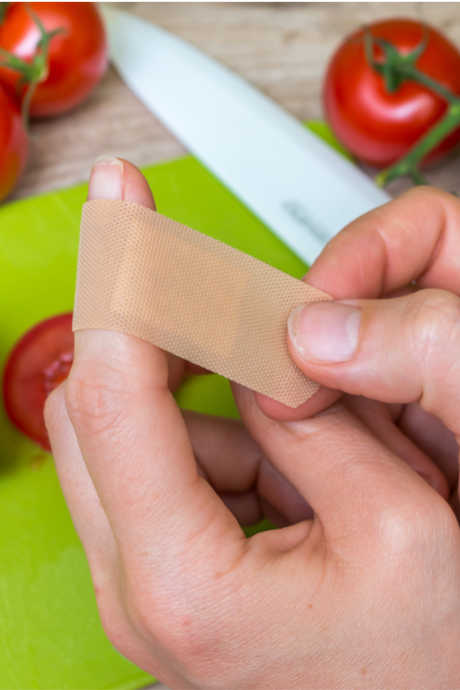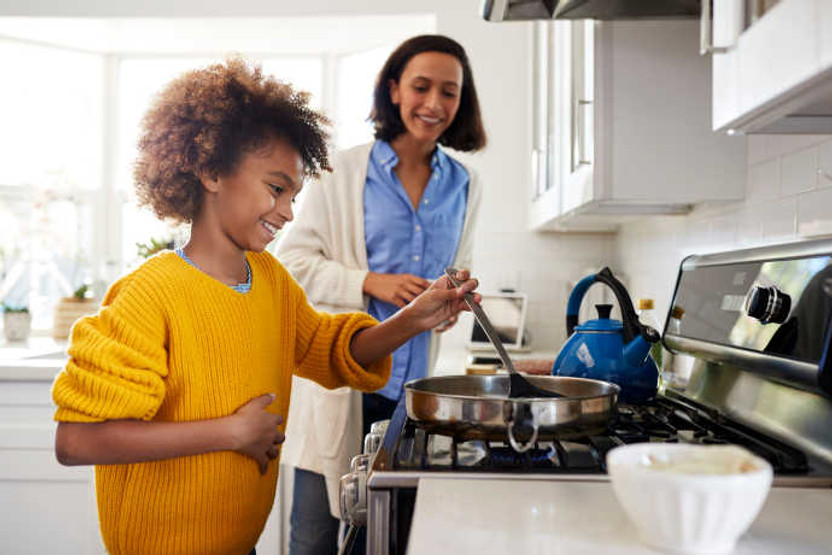Kitchen Safety Tips for Happy and Healthy Holidays
Posted by Julie on Nov 18th 2019
Between now and New Year’s Day, many of us will do more cooking at home than we have all year long. With all that time spent in the kitchen, accidents are bound to happen. Injuries, fires, and foodborne illness are three of the biggest issues we face in the kitchen. But they are preventable with a few key precautions. For those that happen in spite of our best efforts, we can be better prepared to handle them. In this post, we’ll talk about kitchen safety tips, including how to avoid foodborne illness, and how to prevent injuries and fires in the kitchen.
Kitchen Safety: Injury and Fire Prevention
Accidents in the kitchen can include slips and falls, cuts from broken glass or a knife blade, and burns from hot foods or liquids and hot surfaces. Fires can start in a variety of ways, from overheated flammables like grease to malfunctioning electrical appliances. Fortunately, most of these risks can be mitigated through prevention strategies.
Slips and Falls
We’ll start with slips and falls. First, wear shoes while cooking. This may seem silly, but you’re more likely to slip in socks or bare feet. Wear shoes that cover the top of your foot and have a closed toe. They should also have a sturdy sole with a good grip. Next, make sure the floor is clean and dry. If you spill, wipe it up immediately. Even if it’s just water, you’re more likely to slip than if the floor is dry. Finally, don’t climb on the countertop to reach a high shelf. You’re an adult who’s cooking a meal, not a toddler in search of the cookie jar. Invest in a safe stool and check it regularly to ensure it doesn’t wobble.
Cuts
We’ve written before about how keeping knives sharp is essential to knife safety. A dull knife is more likely to slip; instead of slicing your food, it may slice your fingers. Your cutting board can also put you at risk for injuries. If you don’t own a nonslip cutting board, put a damp dish towel under your cutting board. The towel will help prevent your cutting board from sliding on the counter as you cut.

Keep knives away from the edge of the counter when you aren’t using them. Similar to pots and pans on the stove, you don’t want a child to be able to reach up and grab cutlery. If you accidentally drop your knife, let it fall. Get out of the way too, if possible. This is another reason why it’s important to cook with shoes on.
Use knives and other sharp tools properly and only for their intended purpose. This might sound silly, but a lot of injuries happen due to accidents resulting from misuse. If a tool includes safety equipment, like a hand guard or a tamper, use it.
Finally, if glass gets broken, clean it up immediately. Shards of glass can fly in all directions for several feet and have the potential to cause injury if left alone even for a short time. Once again, this is a good reason to wear shoes while cooking.
Burns
Burns can be inflicted by hot foods or liquids and by hot surfaces. On the stovetop, turn the handles of pots and pans so they don’t extend over the edge of the stovetop. Not only will this prevent kids from grabbing at them, you’re also less likely to bump into them yourself. Also, don’t place items on the stovetop unless they are cooking or have finished cooking.

Pull oven racks out several inches when putting baking dishes in the oven or taking them out. This way, you don’t have to reach into the oven and risk burning your hands or arms. Keep kids and pets away from open oven doors to prevent them from jostling you or inadvertently getting burned themselves.
When cooking on the stovetop or in the oven, use oven mitts instead of flat potholders. Mitts protect your entire hand. Potholders may slip, leaving nothing between your skin and a hot pan.
Fires
Home fires are most likely to start in the kitchen, and most home fires happen in the months of December and January. Fortunately, there are several ways you can prevent fires and be better prepared to handle them, even before you start cooking.
First, keep your oven, stovetop, and appliances clean. Not only is it unsanitary to cook with dirty appliances, built-up grease, crumbs, and food spills can catch fire when heated.

Next, buy a fire extinguisher for the kitchen and make sure it’s rated for both grease and electrical fires. The designations you’ll find on fire extinguishers are A, B, and C. A is for combustible materials, B is for flammable liquids, and C is for electrical equipment. For the kitchen, you’ll want a fire extinguisher that is rated for B and C. Also, be aware that fire extinguishers have expiration dates. Check yours regularly and replace it when necessary.
When cooking, don’t wear loose clothing. At best, you’ll dip a sleeve into a saucy dish and stain your clothes. At worst, your clothes may catch fire. Always stay at the stove when cooking food on the stovetop, and stay in the kitchen when cooking food in the oven. If anything catches fire, you will be able to take action quickly, before the fire spreads.
Even with a fire extinguisher at hand, call for help in a fire, first and foremost. If you don’t have a fire extinguisher ready, you can cover a grease fire with a lid, or douse it with baking soda. Be absolutely sure never to use water on a grease fire or electrical fire, as water will cause the flames to spread.
Kitchen Safety: Safe Food Handling
Kitchen injuries and fires aren’t the only risks we run when cooking. Foodborne illness is a significant concern, especially when you’re feeding a crowd and may have food in all stages of preparation and consumption throughout the day.
First, before cooking or handling any type of food, wash your hands thoroughly with soap and warm water. Wash them again every time you handle raw meat, both before and after. Hand washing is the best way to stop the spread of bacteria. Keep your counters, sink, oven, stovetop, and appliances clean too. Wipe down your counters regularly, and scrub out your sink with dish soap and hot water. You can also use soft cleansers on stainless steel and porcelain sinks.
Next, safe food storage is key. Keep packaged raw meat in a plastic bag or set it in a reusable container to prevent leaks from escaping. Then place it on the lowest shelf in the refrigerator to further minimize the risk of leaks onto other foods. Use an appliance thermometer to monitor the internal temperature of your refrigerator. It’s essential to keep it less than 40ºF. The danger zone of food temperatures is between 40ºF and 140ºF, where conditions allow for bacterial growth.

When preparing food, be aware that foods with animal origins (meat, eggs, and dairy) pose the greatest risk of foodborne illness. Raw fruits and vegetables should be washed thoroughly to remove any contaminants. Leafy greens in particular may harbor dirt and bacteria. Use separate cutting boards for raw meat and raw fruit and vegetables. This practice helps prevent cross-contamination. Don’t put cooked food on a cutting board that previously held raw food, especially meat. Nonporous cutting boards are safest to use, especially with raw meat. They are less likely to develop cracks or have crevices where bits of food may get stuck.
Make sure food is cooked thoroughly and that hot foods are kept hot, and cold foods are kept cold. A food thermometer will help you ensure meat is cooked to a safe internal temperature. Refrigerate leftovers promptly to help prevent spoilage. Leftovers should be discarded after four days. Raw meat will keep for two days in the refrigerator; otherwise freeze it and thaw it before using.

